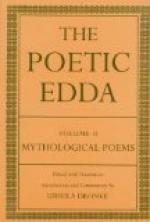Up to this point, the story of Sigurd consists roughly of the same features which mark that of Sigmund and Sinfjoetli. Both are probably, like Helgi, versions of a race-hero myth. In each case there is the usual irregular birth, in different forms, both familiar; a third type, the miraculous or supernatural birth, is attributed by Voelsunga to Sigmund’s father Volsung. Each story again includes a deed of vengeance, and a dragon and treasure. The sword which the hero alone could draw, and the wer-wolf, appear only in the Sigmund and Sinfjoetli version. Among those Germanic races which brought the legend to full perfection, Sigurd’s version soon became the sole one, and Sigmund and Sinfjoetli practically drop out.
The Dragon legend of the Edda is much fuller and more elaborate than that of any other mythology. As a rule tradition is satisfied with the existence of the monster “old and proud of his treasure,” but here we are told its full previous history, certain features of which (such as the shape-shifting) are signs of antiquity, whether it was originally connected with the Volsungs or not.
As usual, Voelsunga gives the fullest account, in the form of a story told by Regin to his foster-son Sigurd, to incite him to slay the dragon. Regin was one of three brothers, the sons of Hreidmar; one of the three, Otr, while in the water in otter’s shape, was seen by three of the Aesir, Odin, Loki and Hoeni, and killed by Loki. Hreidmar demanded as wergild enough gold to fill the otter’s skin, and Loki obtained it by catching the dwarf Andvari, who lived in a waterfall in the form of a fish, and allowing him to ransom his head by giving up his wealth. One ring the dwarf tried to keep back, but in vain; and thereupon he laid a curse upon it: that the ring with the rest of the gold should be the death of whoever should get possession of it. In giving the gold to Hreidmar, Odin also tried to keep back the ring, but had to give it up to cover the last hair. Then Fafni, one of the two remaining sons, killed his father, first victim of the curse, for the sake of the gold. He carried it away and lay guarding it in the shape of a snake. But Regin the smith did not give up his hopes of possessing the hoard: he adopted as his foster-son Sigurd the Volsung, thus getting into his power the hero fated to slay the dragon.
The curse thus becomes the centre of the action, and the link between the two parts of the story, since it directly accounts for Sigurd’s unconscious treachery and his separation from Brynhild, and absolves the hero from blame by making him a victim of fate. It destroys in turn Hreidmar, the Dragon, his brother Regin, the dragon-slayer himself, Brynhild (to whom he gave the ring), and the Giukings, who claimed inheritance after Sigurd’s death. Later writers carried its effects still further.




